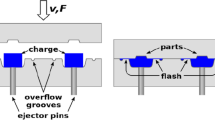Abstract
Laser metal deposition (LMD) has been a promising additive manufacturing technology widely used in mold rapid manufacturing. In order to improve the capacity of LMD for complex curved surface structures, a surface based variable thickness slicing (S-VTS) model is proposed to adaptively generate the LMD process based on the geometric characteristics of structures. Two deposition strategies in scanning and overlapping directions are designed to enable variable thickness of each cladding layer by dynamically adjusting the scanning speed and overlapping rate. To improve the surface quality and forming efficiency, the discrete particle swarm optimization (DPSO) algorithm is adopt to optimize the process parameters of S-VTS model, including the number of cladding layer, scanning pass, and segment per pass. Several experiments are conducted to form the cuboid samples with wavy and freeform surface and verify the feasibility of the S-VTS model. The results demonstrate that under the open-loop control condition, the geometric accuracy, surface quality, and efficiency of the proposed method is improved in comparison with uniform thickness slicing (UTS) deposition. Moreover, heterogeneous microstructure is always generated by the S-VTS method in terms of grain size and growth direction.


















Similar content being viewed by others
References
Santos EC, Shiomi M, Osakada K, Laoui T (2006) Rapid manufacturing of metal components by laser forming. Int J Mach Tools Manuf 46(12–13):1459–1468
Lewandowski JJ, Seifi M (2016) Metal additive manufacturing: a review of mechanical properties. Annu Rev Mater Res 46:151–186
Chen L, Chung MF, Tian Y, Joneja A, Tang K (2019) Variable-depth curved layer fused deposition modeling of thin-shells. Robot Comput Integr Manuf 57:422–434
McCaw JC, Cuan-Urquizo E (2018) Curved-layered additive manufacturing of non-planar, parametric lattice structures. Mater Des 160:949–963
Kumar M, Roy Choudhury A (2002) Adaptive slicing with cubic patch approximation. Rapid Prototyp J 8(4):224–232
Huang B, Singamneni S (2015) A mixed-layer approach combining both flat and curved layer slicing for fused deposition modelling. Proc Inst Mech Eng B J Eng Manuf 229(12):2238–2249
Shi T, Lu B, Shi S, Meng W, Fu G (2017) Laser metal deposition with spatial variable orientation based on hollow-laser beam with internal powder feeding technology. Opt Laser Technol 88:234–241
Fathi A, Khajepour A, Durali M, Toyserkani E (2008) Geometry control of the deposited layer in a nonplanar laser cladding process using a variable structure controller. J Manuf Sci Eng 130(3):031003
Ruan J, Tang L, Liou FW, Landers RG (2010) Direct three-dimensional layer metal deposition. J Manuf Sci Eng 132(6):064502
Pi G, Zhang A, Zhu G, Li D, Lu B (2011) Research on the forming process of three-dimensional metal parts fabricated by laser direct metal forming. Int J Adv Manuf Technol 57(9–12):841–847
Ansari M, Razavi RS, Barekat M (2016) An empirical-statistical model for coaxial laser cladding of NiCrAlY powder on Inconel 738 superalloy. Opt Laser Technol 86:136–144
Chen C, Lian G, Jiang J, Wang Q (2018) Simplification and experimental investigation of geometrical surface smoothness model for multi-track laser cladding processes. J Manuf Process 36:621–628
Cao Y, Zhu S, Liang X, Wang W (2011) Overlapping model of beads and curve fitting of bead section for rapid manufacturing by robotic MAG welding process. Robot Comput Integr Manuf 27(3):641–645
Ding D, Pan Z, Cuiuri D, Li H (2015) A multi-bead overlapping model for robotic wire and arc additive manufacturing (WAAM). Robot Comput Integr Manuf 31:101–110
Nickel AH, Barnett DM, Prinz FB (2001) Thermal stresses and deposition patterns in layered manufacturing. Mater Sci Eng A 317(1–2):59–64
Yu J, Lin X, Ma L, Wang J, Fu X, Chen J, Huang W (2011) Influence of laser deposition patterns on part distortion, interior quality and mechanical properties by laser solid forming (LSF). Mater Sci Eng A 528(3):1094–1104
Zhang K, Wang S, Liu W, Shang X (2014) Characterization of stainless steel parts by laser metal deposition shaping. Mater Des 55:104–119
Bax B, Rajput R, Kellet R, Reisacher M (2018) Systematic evaluation of process parameter maps for laser cladding and directed energy deposition. Addit Manuf 21:487–494
Ding D, Pan Z, Cuiuri D, Li H (2015) Wire-feed additive manufacturing of metal components: technologies, developments and future interests. Int J Adv Manuf Technol 81(1–4):465–481
Gu DD, Meiners W, Wissenbach K, Poprawe R (2012) Laser additive manufacturing of metallic components: materials, processes and mechanisms. Int Mater Rev 57(3):133–164
Frazier WE (2014) Metal additive manufacturing: a review. J Mater Eng Perform 23(6):1917–1928
Li W, Soshi M (2019) Modeling analysis of the effect of laser transverse speed on grain morphology during directed energy deposition process. Int J Adv Manuf Technol 103:3279–3291
Farshidianfar MH, Khajepour A, Gerlich AP (2016) Effect of real-time cooling rate on microstructure in laser additive manufacturing. J Mater Process Technol 231:468–478
Guo P, Zou B, Huang C, Gao H (2017) Study on microstructure, mechanical properties and machinability of efficiently additive manufactured AISI 316L stainless steel by high-power direct laser deposition. J Mater Process Technol 240:12–22
Liu W, Wei H, Huang C, Yuan F, Zhang Y (2019) Energy efficiency evaluation of metal laser direct deposition based on process characteristics and empirical modeling. Int J Adv Manuf Technol 102(1–4):901–913
Author information
Authors and Affiliations
Corresponding author
Additional information
Publisher’s note
Springer Nature remains neutral with regard to jurisdictional claims in published maps and institutional affiliations.
Rights and permissions
About this article
Cite this article
Xin, B., Zhou, X. & Gong, Y. Surface based variable thickness slicing modeling for laser metal deposition. Int J Adv Manuf Technol 107, 463–474 (2020). https://doi.org/10.1007/s00170-020-05023-4
Received:
Accepted:
Published:
Issue Date:
DOI: https://doi.org/10.1007/s00170-020-05023-4



